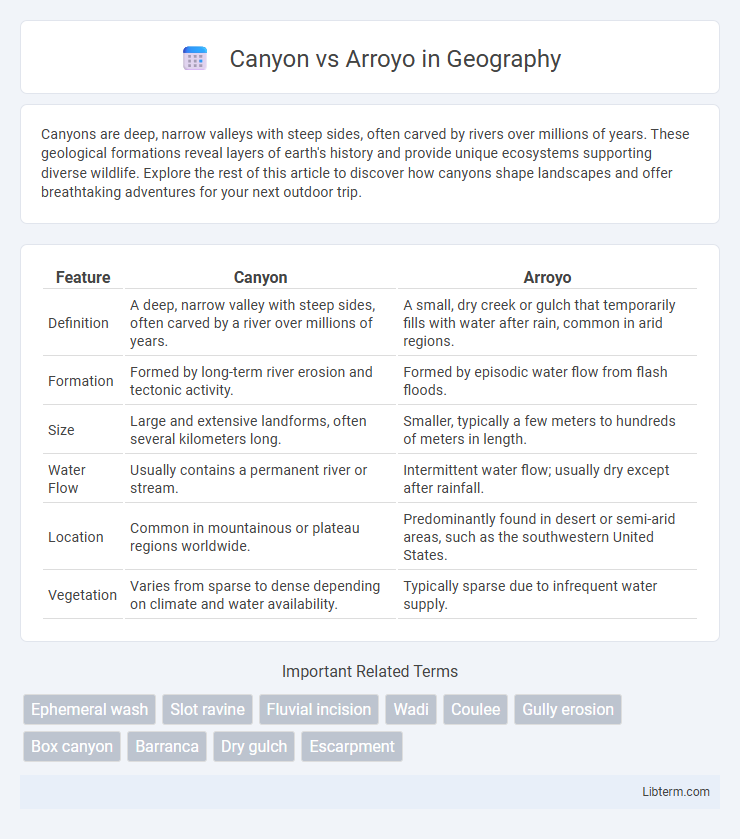Canyons are deep, narrow valleys with steep sides, often carved by rivers over millions of years. These geological formations reveal layers of earth's history and provide unique ecosystems supporting diverse wildlife. Explore the rest of this article to discover how canyons shape landscapes and offer breathtaking adventures for your next outdoor trip.
Table of Comparison
| Feature | Canyon | Arroyo |
|---|---|---|
| Definition | A deep, narrow valley with steep sides, often carved by a river over millions of years. | A small, dry creek or gulch that temporarily fills with water after rain, common in arid regions. |
| Formation | Formed by long-term river erosion and tectonic activity. | Formed by episodic water flow from flash floods. |
| Size | Large and extensive landforms, often several kilometers long. | Smaller, typically a few meters to hundreds of meters in length. |
| Water Flow | Usually contains a permanent river or stream. | Intermittent water flow; usually dry except after rainfall. |
| Location | Common in mountainous or plateau regions worldwide. | Predominantly found in desert or semi-arid areas, such as the southwestern United States. |
| Vegetation | Varies from sparse to dense depending on climate and water availability. | Typically sparse due to infrequent water supply. |
Defining Canyons and Arroyos
Canyons are deep, narrow valleys with steep sides, typically formed by long-term erosion from rivers or tectonic activity. Arroyos are dry creek beds or gullies that temporarily fill with water after heavy rains, common in arid and semi-arid regions. The primary difference lies in canyons being permanent geological formations, while arroyos are ephemeral channels shaped by intermittent water flow.
Geological Formation Processes
Canyons form primarily through prolonged erosion by rivers cutting deeply into bedrock, creating steep walls and narrow valleys over millions of years. Arroyos are dry creek beds found in arid regions, shaped by episodic flash floods that rapidly erode soft sediment and create steep-sided channels. Both formations result from water erosion, but canyons develop through sustained river activity, while arroyos form from sudden, intense water flow events.
Key Physical Differences
Canyons are typically deep, narrow valleys with steep sides formed by river erosion over millions of years, often featuring rock layers exposed and winding paths. Arroyo refers to a dry creek or stream bed that temporarily fills with water after rain, usually shallow and less extensive than canyons. The primary physical difference lies in their scale and permanence: canyons are large and perennial landforms, while arroyos are smaller, intermittent channels primarily found in arid regions.
Locations Around the World
Canyons, such as the Grand Canyon in the USA and Fish River Canyon in Namibia, are deep, narrow valleys with steep sides carved primarily by rivers, often found in arid or semi-arid regions worldwide. Arroyos, common in the Southwestern United States, Mexico, and parts of South America, are dry creek or riverbeds that temporarily fill with water during heavy rains. Both landforms are integral to understanding regional hydrology and erosion processes but differ in scale and permanence across locations.
Ecological Importance
Canyons and arroyos serve crucial ecological roles by supporting diverse habitats and promoting water retention in arid environments. Canyons often host unique microclimates and endemic plant species due to their varied elevations and protected conditions. Arroyos, as ephemeral stream channels, facilitate nutrient cycling and groundwater recharge during rain events, sustaining local wildlife populations.
Role in Water Flow and Erosion
Canyons are deep, narrow valleys with steep sides formed primarily by the long-term erosion from a river or stream cutting through hard rock, actively channeling significant water flow that shapes the landscape over millions of years. Arroyos, also known as dry creeks or washes, are shallow, intermittent channels found mostly in arid regions that experience rapid water flow only during heavy rainfall, leading to sudden but intense erosion and sediment transport. The role of a canyon in water flow is continuous and consistent, carving profound geological features, whereas an arroyo primarily influences erosion episodically with flash flooding events that reshape desert terrain.
Significance in Local Climate
Canyons significantly influence local climate by channeling wind patterns and creating microclimates with temperature variations due to their steep walls and shaded areas. Arroyo environments, characterized by dry creek beds, impact local humidity and runoff dynamics, often intensifying seasonal flooding and soil moisture variability. Both formations play crucial roles in shaping localized weather phenomena and ecological conditions within their regions.
Human Interaction and Uses
Canyons often serve as crucial sites for human interaction, providing natural pathways for transportation, settlements, and recreational activities such as hiking and rock climbing. Arroyo channels, typically dry except during rainstorms, are frequently used for water management, irrigation, and as natural drainage systems in arid regions. Both landforms influence local ecosystems and have cultural significance, but canyons generally support more permanent human uses due to their larger scale and accessibility.
Famous Examples of Each
The Grand Canyon in Arizona is among the most famous canyons globally, known for its immense size and intricate geological layers. In contrast, the Arroyo Seco in California is a well-known arroyo characterized by a dry creek bed that flows during heavy rains, showcasing typical arroyo features. These iconic examples highlight the distinct formations where canyons are deep gorges carved by rivers over millions of years, while arroyos are seasonal watercourses found mainly in arid regions.
Summary: Choosing the Right Term
A canyon refers to a deep, narrow valley with steep sides, often formed by river erosion over millions of years, while an arroyo is a dry creek or stream bed that temporarily fills with water after heavy rain. Selecting the appropriate term depends on geographic and climatic context; canyons are prevalent in arid and semi-arid regions with significant erosion, whereas arroyos are typical in desert landscapes with intermittent water flow. Proper terminology enhances clarity in geological and geographical descriptions.
Canyon Infographic

 libterm.com
libterm.com